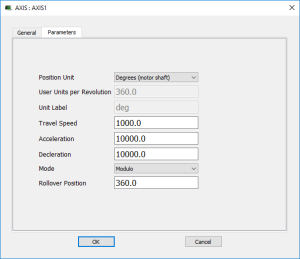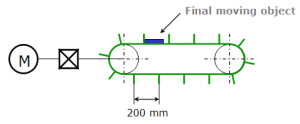Set the Axis Block Position Units
You can set up the position![]() Position means a point in space which is described by different coordinates.
Depending on the used system and transformation it can consist of a maximum of six dimensions (coordinates).This means three Cartesian coordinates in space and coordinates for the orientation.
In ACS there can be even more than six coordinates.
If the same position is described in different coordinate systems the values of the coordinates are different. units in the parameter screen of the Axis block.
Position means a point in space which is described by different coordinates.
Depending on the used system and transformation it can consist of a maximum of six dimensions (coordinates).This means three Cartesian coordinates in space and coordinates for the orientation.
In ACS there can be even more than six coordinates.
If the same position is described in different coordinate systems the values of the coordinates are different. units in the parameter screen of the Axis block.
Figure 1: Setting Axis Units
Some guidelines for suitable settings are given below:
- The user unit is adapted for the machine
 The complete assembly of all connected parts or devices, of which at least one is movable.
The complete assembly of all connected parts or devices, of which at least one is movable. - The user unit should be meaningful for the user
- The same user unit should be used for all related axes, for simplicity
- The user unit should refer to the position of the final moving object, instead of any intermediate part (e.g. the belt position rather than the position of the axis shaft)
Speed![]() Speed is the absolute value of the velocity without direction. is defined in User Units for position / second, e.g. cm/s
Speed is the absolute value of the velocity without direction. is defined in User Units for position / second, e.g. cm/s
Figure 2: Setting the Units - Example
In this example, the belt flaps are about 60 degrees away from each other on the wheel, so 6 flaps would pass on a rotation of the axis. This corresponds to 1200mm/revolution. Because the diagram specifies millimeters, one should select “Custom![]() User modified or defined material (e.g., custom units or custom settings).” from the Position Unit drop down box, enter “1200.0” into the User Units Per Revolution text box, and “mm” box into the Unit label text box.
User modified or defined material (e.g., custom units or custom settings).” from the Position Unit drop down box, enter “1200.0” into the User Units Per Revolution text box, and “mm” box into the Unit label text box.








